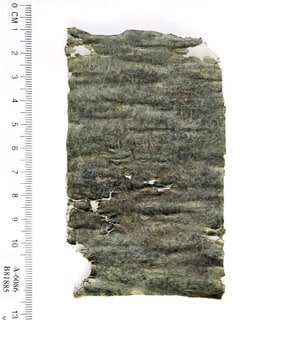In archaeological excavations conducted by the Antiquities Authority in the Givati parking lot in the City of David, a rolled lead plate bearing an inscription in Greek was recently discovered

In archaeological excavations conducted by the Antiquities Authority in the Givati parking lot in the City of David, a rolled lead plate bearing an inscription in Greek was recently discovered. This is a magical tablet bearing a curse, apparently written by a professional magician/sorcerer.
According to Dr. Doron Ben Ami and Yana Chachanovitz, the managers of the excavation on behalf of the Antiquities Authority, "the plaque was discovered in one of the rooms of an enormous building from the Roman period, which was excavated at the site during the last few years. The building, which was erected during the third century AD at the northern end of the City of David branch, was destroyed in the earthquake that struck the area in 363 AD, as evidenced by the many coins found among the rubble of its second floor. Inside the landslide village excavated in its northeastern corner, a variety of objects from the period were found, which include, in addition to the discussed lead plate, also a large amount of roof tiles imprinted with the imprint of the 70th Legion that camped in the city after its destruction in XNUMX AD, bone and ivory objects, clay figurines and other finds that testify to their material culture the wealth of its inhabitants. Remains of frescoes (colored plaster) found in the landslides are evidence of the existence of the walls of the second floor decorated with paint in geometric and plant patterns.
Would you like to read more on the science website?
- Witch hunt - definitely not Halloween
- The mushroom, the witch and the dirty wardrobe of the soul - on the dark side of the Salem witch trials
- The witch received government funding to start a business
- A 12-year-old 'witch' skeleton was discovered in a cave in the Galilee
- the witch
A lead plate, which at the time of its discovery resembled a small tube, was sent for the purpose of opening it to the Antiquities Authority laboratories. It was the eyes of the watchman Lena Kuperschmidt who saw it for the first time - since it was written and scrolled about 1700 years ago, in the ancient script. This, after working hard for many days to open it. Iron patience was needed to open the lead plate - because any attempt to open it quickly could cause irreversible damage to the address. When the plate was opened it turned out that it is in an excellent state of preservation, and includes an inscription in Greek that covers the entire surface of one side while the back of the plate is smooth.
The text is written in an eloquent script, and it is evident that it was not written by Kirila herself, but by a professional magician hired by her - this is shown by the analysis of Dr. Robert Daniel from the University of Cologne in Germany, a world-renowned expert in the field, to whom the tablet was sent for reading. The inscription flattens the spell that a woman named Kirila seeks to cast on a man named Yanis, apparently following a legal dispute whose nature is unclear. To this end, she calls for the help of the gods of the underworld, including Pluto, Hermes, Persephone, and even the Mesopotamian goddess Ereshkigal is required for the task.

"I hit and nailed the tongue, the eyes, the rage, the chastity, the rejection/procrastination and the resistance of Yannis" - said Kirila in one section of the magical curse plate. It is possible that we have before us a metaphorical description of actions taken by Kirila aimed at giving her control over her legal opponent. At the same time, the possibility should not be ruled out that the writing of the text on the plate was accompanied, quite literally, by beating with a hammer and nails performed by Kirila on the image (?) of Yanis - a kind of ancient voodoo ritual.
Kirila buried the tablet in the place identified with this Yannis - and therefore it is possible that the room on the top floor where the tablet was discovered in the ruins of the village was his place of residence. Alternatively, it is possible that in this corner of the Roman building there was a courtroom, where the trial of Cyril and Yannis took place. Apparently, Kirila buried the object not long before the destruction of the building, in the earthquake that followed the building was abandoned and no longer blows.
